Processing Framework for Landslide Detection Based on Synthetic Aperture Radar (SAR) Intensity-Image Analysis
Abstract
:1. Introduction
2. Background
3. Methods
- (1)
- Data ingestion and preprocessing (Figure 2a), and change detection (Figure 2b), discussed in Section 3.1;
- (2)
- Object-based image analysis, including object feature extraction, as well as image segmentation and object classification (Figure 2d), by making use of polarimetric decomposition (Figure 2c), discussed in Section 3.2.
3.1. Preprocessing of Intensity Image and Change Detection
3.2. Object-Based Image Analysis
3.2.1. Object-Based Feature Extraction
3.2.2. Image Segmentation and Object Classification
3.3. Study Area
4. Results and Discussion
5. Conclusions and Outlook
Author Contributions
Funding
Data Availability Statement
Acknowledgments
Conflicts of Interest
References
- Juan, V.; Lo, H.; Chen, C.H. Geotectonics of Taiwan—An Overview. In Geodynamics of the Western Pacific Indonesian Region; Hilde, T.W.C., Uyeda, S., Eds.; American Geophysical Union: Washington, DC, USA, 1983; pp. 379–386. [Google Scholar]
- Chingchang, B.; Shyu, C.T.; Chen, J.C.; Boggs, S. Taiwan: Geology, Geophysics, and Marine Sediments. In The Ocean Basins and Margins; Nairn, A.E.M., Stehli, F.G., Uyeda, S., Eds.; Springer: Boston, MA, USA, 1985. [Google Scholar] [CrossRef]
- Ho, T.S. A Synthesis of the Geologic Evolution of Taiwan. Tectonophysics 1986, 125. [Google Scholar] [CrossRef]
- Byrne, T.; Liu, C. Introduction to the Geology and Geophysics of Taiwan. In Geology and Geophysics of an Arc-Continent Collision, Taiwan; The Geological Society of America: Boulder, CO, USA, 2002; Volume 358. [Google Scholar] [CrossRef]
- Malavieille, J.; Lallemand, S.E.; Dominguez, S.; Deschamps, A.; Lu, C.Y.; Liu, C.S.; Schnurle, P. The ACT (Active Collision in Taiwan) Scientific Crew. Arccontinent collision in Taiwan: New marine observations and tectonic evolution. In Geology and Geophysics of an Arc-Continent collision, Taiwan; Byrne, T.B., Liu, C.S., Eds.; Geological Society of America: Boulder, CO, USA, 2002; Volume 358, pp. 187–211. [Google Scholar] [CrossRef] [Green Version]
- Chen, S.C.; Huang, B.T. Non-structural mitigation programs for sediment-related disasters after the Chichi Earthquake in Taiwan. J. Mt. Sci. 2010, 7, 291–300. [Google Scholar] [CrossRef] [Green Version]
- Central Weather Bureau. FAQ for Typhoon. 2020. Available online: http://www.cwb.gov.tw/eng (accessed on 1 November 2020).
- Aleotti, P.; Chowdhury, R. Landslide hazard assessment: Summary review and new perspectives. Bull. Eng. Geol. Environ. 1999, 58, 21–44. [Google Scholar] [CrossRef]
- Ho, C.S. An Introduction to the Geology of Taiwan: Explanatory Text of the Geologic Map of Taiwan; Central Geological Survey, Ministry of Economic Affairs: Taipei City, Taiwan, 1988. [Google Scholar]
- Nikolakopoulos, K.; Kavoura, K.; Depountis, N.; Kyriou, A.; Argyropoulos, N.; Koukouvelas, I.; Sabatakakis, N. Preliminary results from active landslide monitoring using multidisciplinary surveys. Eur. J. Remote Sens. 2017, 50, 280–299. [Google Scholar] [CrossRef] [Green Version]
- Wu, C.C. Typhoon Morakot: Key Findings from the Journal for Improving Prediction of Extreme Rains at Landfall. Bull. Am. Meteor. Soc. 2013, 94, 155–160. [Google Scholar] [CrossRef]
- Lie, H.; Hsieh, L.S.; Chen, L.C.; Lin, L.Y.; Li, W.S. Disaster investigation and analysis of Typhoon Morakot. J. Chin. Inst. Eng. 2014, 37, 558–569. [Google Scholar] [CrossRef]
- Xie, H.; Zhong, Z.X.; Huang, J.Y. Application of NDVI and average value adjustment image segmentation method for the extraction of collapsed bare land using multi-level Formosat-2 images in the Liugui forest area (in Chinese). Taiwan For. Sci. 2017, 32, 203–222. [Google Scholar]
- Bell, F.G. Geological Hazards: Their Assessment, Avoidance and Mitigation; CRC Press: Boca Raton, FL, USA, 2003. [Google Scholar]
- Barbarella, M.; Fiani, M. Monitoring of large landslides by Terrestrial Laser Scanning techniques: Field data collection and processing. Eur. J. Remote Sens. 2013, 46, 126–151. [Google Scholar] [CrossRef]
- Corominas, J.; Moya, J.; Lloret, A.; Gili, J.; Angeli, M.G.; Pasuto, A.; Silvano, S. Measurement of landslide displacements using a wire extensometer. Eng. Geol. 2000, 55, 149–166. [Google Scholar] [CrossRef]
- Zhao, C.; Lu, Z. Remote Sensing of Landslides—A Review. Remote Sens. 2018, 10, 279. [Google Scholar] [CrossRef] [Green Version]
- Plank, S.; Hölbling, D.; Eisank, C.; Friedl, B.; Martinis, S.; Twele, A. Comparing object-based landslide detection methods based on polarimetric SAR and optical satellite imagery—A case study in Taiwan. In Proceedings of the 7th International Workshop on Science and Applications of SAR Polarimetry and Polarimetric Interferometry, Frascati, Italy, 26–30 January 2015. [Google Scholar]
- Wang, C.; Mao, X.; Wang, Q. Landslide displacement monitoring by a fully polarimetric SAR offset tracking method. Remote Sens. 2016, 8, 624. [Google Scholar] [CrossRef] [Green Version]
- Kang, Y.; Zhao, C.; Zhang, Q.; Lu, Z.; Li, B. Application of InSAR Techniques to an Analysis of the Guanling Landslide. Remote Sens. 2017, 9, 1046. [Google Scholar] [CrossRef] [Green Version]
- Schlögel, R.; Thiebes, B.; Mulas, M.; Cuozzo, G.; Notarnicola, C.; Schneiderbauer, S.; Crespi, M.; Mazzoni, A.; Mair, V.; Corsini, A. Multi-Temporal X-Band Radar Interferometry Using Corner Reflectors: Application and Validation at the Corvara Landslide (Dolomites, Italy). Remote Sens. 2017, 9, 739. [Google Scholar] [CrossRef] [Green Version]
- Du, Y.; Xu, Q.; Zhang, L.; Feng, G.; Li, Z.; Chen, R.; Lin, C. Recent landslide movement in Tsaoling, Taiwan tracked by TerraSAR-X/TanDEM-X DEM time series. Remote Sens. 2017, 9, 353. [Google Scholar] [CrossRef] [Green Version]
- Mondini, A. Measures of Spatial Autocorrelation Changes in Multitemporal SAR Images for Event Landslides Detection. Remote Sens. 2017, 9, 554. [Google Scholar] [CrossRef] [Green Version]
- Bru, G.; González, P.J.; Mateos, R.M.; Roldán, F.; Herrera, G.; Béjar-Pizarro, M.; Fernández, J.A. Monitoring of Landslide and Subsidence Activity: A Case of Urban Damage in Arcos de la Frontera. Remote Sens. 2017, 9, 787. [Google Scholar] [CrossRef] [Green Version]
- Bardi, F.; Raspini, F.; Frodella, W.; Lombardi, L.; Nocentini, M.; Gigli, G.; Morelli, S.; Corsini, A.; Casagli, N. Monitoring the Rapid-Moving Reactivation of Earth Flows by Means of GB-InSAR: The April 2013 Capriglio Landslide (Northern Appennines, Italy). Remote Sens. 2017, 9, 165. [Google Scholar] [CrossRef] [Green Version]
- Konishi, T.; Suga, Y. Landslide detection using COSMO-SkyMed images: A case study of a landslide event on Kii Peninsula, Japan. Eur. J. Remote Sens. 2018, 51, 205–221. [Google Scholar] [CrossRef] [Green Version]
- Lin, K.F.; Perissin, D. Hybrid analysis for SAR change detection based on time series data. In Proceedings of the IEEE International Geoscience and Remote Sensing Symposium (IGARSS), Fort Worth, TX, USA, 23–28 July 2017; pp. 1079–1082. [Google Scholar] [CrossRef]
- Chen, G.; Hay, G.J.; Carvalho, L.M.; Wulder, M.A. Object-based change detection. Int. J. Remote Sens. 2012, 33, 4434–4457. [Google Scholar] [CrossRef]
- Hussain, M.; Chen, D.; Cheng, A.; Wei, H.; Stanley, D. Change detection from remotely sensed images: From pixel-based to object-based approaches. ISPRS J. Photogramm. Remote Sens. 2013, 80, 91–106. [Google Scholar] [CrossRef]
- Lu, D.; Mausel, P.; Brondizio, E.; Moran, E. Change detection techniques. Int. J. Remote Sens. 2004, 25, 2365–2401. [Google Scholar] [CrossRef]
- Lunetta, R.S.; Johnson, D.M.; Lyon, J.G.; Crotwell, J. Impacts of imagery temporal frequency on land-cover change detection monitoring. Remote Sens. Environ. 2004, 89, 444–454. [Google Scholar] [CrossRef]
- Czuchlewski, K.R.; Weissel, J.K.; Kim, Y. Polarimetric synthetic aperture radar study of the Tsaoling landslide generated by the 1999 Chi-Chi earthquake, Taiwan. J. Geophys. Res. Earth Surf. 2003, 108. [Google Scholar] [CrossRef]
- Green, K.; Kempka, D.; Lackey, L. Using remote sensing to detect and monitor land-cover and land-use change. Photogramm. Eng. Remote Sens. 1994, 60, 331–337. [Google Scholar]
- Colesanti, C.; Wasowski, J. Investigating landslides with space-borne Synthetic Aperture Radar (SAR) interferometry. Eng. Geol. 2006, 88, 173–199. [Google Scholar] [CrossRef]
- Cascini, L.; Fornaro, G.; Peduto, D. Analysis at medium scale of low-resolution DInSAR data in slow-moving landslide-affected areas. ISPRS J. Photogramm. Remote Sens. 2009, 64, 598–611. [Google Scholar] [CrossRef]
- Cascini, L.; Fornaro, G.; Peduto, D. Advanced low-and full-resolution DInSAR map generation for slow-moving landslide analysis at different scales. Eng. Geol. 2010, 112, 29–42. [Google Scholar] [CrossRef]
- Bianchini, S.; Herrera, G.; Mateos, R.M.; Notti, D.; Garcia, I.; Mora, O.; Moretti, S. Landslide activity maps generation by means of persistent scatterer interferometry. Remote Sens. 2013, 5, 6198–6222. [Google Scholar] [CrossRef] [Green Version]
- Nico, G.; Oliveira, S.; Catalão, J.; Zêzere, J. Generation of Persistent Scatterers in Non-Urban Areas: The Role of Microwave Scattering Parameters. Geosciences 2018, 8, 269. [Google Scholar] [CrossRef] [Green Version]
- Notti, D.; Herrera, G.; Bianchini, S.; Meisina, C.; García-Davalillo, J.C.; Zucca, F. A methodology for improving landslide PSI data analysis. Int. J. Remote Sens. 2014, 35, 2186–2221. [Google Scholar] [CrossRef]
- García-Davalillo, J.C.; Herrera, G.; Notti, D.; Strozzi, T.; Álvarez Fernández, I. DInSAR analysis of ALOS PALSAR images for the assessment of very slow landslides: The Tena Valley case study. Landslides 2014, 11, 225–246. [Google Scholar] [CrossRef]
- Bazi, Y.; Bruzzone, L.; Melgani, F. An unsupervised approach based on the generalized Gaussian model to automatic change detection in multitemporal SAR images. IEEE Trans. Geosci. Remote Sens. 2005, 43, 874–887. [Google Scholar] [CrossRef] [Green Version]
- Bovolo, F.; Bruzzone, L. A detail-preserving scale-driven approach to change detection in multitemporal SAR images. IEEE Trans. Geosci. Remote Sens. 2005, 43, 2963–2972. [Google Scholar] [CrossRef]
- Hemasinghe, H.; Rangali, R.; Deshapriya, N.; Samarakoon, L. Landslide susceptibility mapping using logistic regression model (a case study in Badulla District, Sri Lanka). Procedia Eng. 2015, 212, 1046–1053. [Google Scholar] [CrossRef]
- Mondini, A.C.; Santangelo, M.; Rocchetti, M.; Rossetto, E.; Manconi, A.; Monserrat, O. Sentinel-1 SAR amplitude imagery for rapid landslide detection. Remote Sens. 2019, 11, 760. [Google Scholar] [CrossRef] [Green Version]
- Oliver, C.; Quegan, S. Understanding Synthetic Aperture Radar Images; SciTech Publishing: Chennai, India, 2004. [Google Scholar]
- Bru, G.; Escayo, J.; Fernández, J.; Mallorqui, J.; Iglesias, R.; Sansosti, E.; Morales, A. Suitability Assessment of X-Band Satellite SAR Data for Geotechnical Monitoring of Site Scale Slow Moving Landslides. Remote Sens. 2018, 10, 936. [Google Scholar] [CrossRef] [Green Version]
- Cigna, F.; Bateson, L.B.; Jordan, C.J.; Dashwood, C. Simulating SAR geometric distortions and predicting Persistent Scatterer densities for ERS-1/2 and ENVISAT C-band SAR and InSAR applications: Nationwide feasibility assessment to monitor the landmass of Great Britain with SAR imagery. Remote Sens. Environ. 2014, 152, 441–466. [Google Scholar] [CrossRef] [Green Version]
- Notti, D.; Meisina, C.; Zucca, F.; Colombo, A. Models to predict Persistent Scatterers data distribution and their capacity to register movement along the slope. In Proceedings of the Fringe 2011 Workshop, Frascati, Italy, 19–23 September 2011. [Google Scholar]
- Novellino, A.; Cigna, F.; Brahmi, M.; Sowter, A.; Bateson, L.; Marsh, S. Assessing the feasibility of a national InSAR ground deformation map of Great Britain with Sentinel-1. Geosciences 2017, 7, 19. [Google Scholar] [CrossRef] [Green Version]
- Rignot, E.J.; Van Zyl, J.J. Change detection techniques for ERS-1 SAR data. IEEE Trans. Geosci. Remote Sens. 1993, 31, 896–906. [Google Scholar] [CrossRef] [Green Version]
- Mansourpour, M.; Rajabi, M.; Blais, J. Effects and performance of speckle noise reduction filters on active radar and SAR images. In Proceedings of the International Society for Photogrammetry and Remote Sensing (ISPRS) Archives, Volume XXXVI-1/W41, Ankara, Turkey, 14–16 February 2006. [Google Scholar]
- Lu, P.; Stumpf, A.; Kerle, N.; Casagli, N. Object-oriented change detection for landslide rapid mapping. IEEE Geosci. Remote Sens. Lett. 2011, 8, 701–705. [Google Scholar] [CrossRef]
- Friedl, B.; Hölbling, D. Using SAR Interferograms and Coherence Images for Object-Based Delineation of Unstable Slopes. In Proceedings of the FRINGE 2015 Workshop: Advances in the Science and Applications of SAR Interferometry and Sentinel-1 InSAR Workshop, Frascati, Italy, 23–27 March 2015; European Space Agency: Frascati, Italy, 2015. [Google Scholar]
- Kunwar, S. Segmentation and Classification of Nepal Earthquake Induced Landslides Using SENTINEL-1 Product. Int. Arch. Photogramm. Remote Sens. Spat. Inf. Sci. 2016, 41, 769. [Google Scholar] [CrossRef]
- Esposito, G.; Mondini, A.C.; Marchesini, I.; Reichenbach, P.; Salvati, P.; Rossi, M. An example of SAR-derived image segmentation for landslides detection. In Proceedings of the Open Source Geospatial Research and Education Symposium (OGRS2018), Lugano, Switzerland, 9–11 October 2018. [Google Scholar]
- Martha, T.R.; Kerle, N.; van Westen, C.J.; Jetten, V.; Kumar, K.V. Segment optimization and data-driven thresholding for knowledge-based landslide detection by object-based image analysis. IEEE Trans. Geosci. Remote Sens. 2011, 49, 4928–4943. [Google Scholar] [CrossRef]
- Cloude, S.R.; Pottier, E. A review of target decomposition theorems in radar polarimetry. IEEE Trans. Geosci. Remote Sens. 1996, 34, 498–518. [Google Scholar] [CrossRef]
- Ferro-Famil, L.; Pottier, E.; Lee, J. Unsupervised classification of natural scenes from polarimetric interferometric SAR data. Front. Remote. Sens. Inf. Process. 2003, 105–137. [Google Scholar] [CrossRef]
- Yonezawa, C.; Watanabe, M.; Saito, G. Polarimetric decomposition analysis of ALOS PALSAR observation data before and after a landslide event. Remote Sens. 2012, 4, 2314–2328. [Google Scholar] [CrossRef] [Green Version]
- Huynen, J.R. Phenomenological Theory of Radar Targets. Ph.D. Thesis, Electrical Engineering, Mathematics and Computer Science, TU Delft, Delft, The Netherlands, 1970. [Google Scholar]
- Cloude, S.R.; Pottier, E. An entropy based classification scheme for land applications of polarimetric SAR. IEEE Trans. Geosci. Remote Sens. 1997, 35, 68–78. [Google Scholar] [CrossRef]
- Lee, J.S.; Grunes, M.R.; Ainsworth, T.L.; Du, L.J.; Schuler, D.L.; Cloude, S.R. Unsupervised classification using polarimetric decomposition and the complex Wishart classifier. IEEE Trans. Geosci. Remote Sens. 1999, 37, 2249–2258. [Google Scholar] [CrossRef]
- Geary, R.C. The contiguity ratio and statistical mapping. Inc. Stat. 1954, 5, 115–146. [Google Scholar] [CrossRef]
- Getis, A.; Ord, J.K. The Analysis of Spatial Association by Use of Distance Statistics. Geogr. Anal. 1992, 24, 189–207. [Google Scholar] [CrossRef]
- Anselin, L. Local Indicators of Spatial Association—LISA. Geogr. Anal. 1995, 27, 93–115. [Google Scholar] [CrossRef]
- Kalia, A. Classification of Landslide Activity on a Regional Scale Using Persistent Scatterer Interferometry at the Moselle Valley (Germany). Remote Sens. 2018, 10, 1880. [Google Scholar] [CrossRef] [Green Version]
- Mahrooghy, M.; Aanstoos, J.V.; Nobrega, R.A.; Hasan, K.; Prasad, S.; Younan, N.H. A machine learning framework for detecting landslides on earthen levees using spaceborne SAR imagery. IEEE J. Sel. Top. Appl. Earth Obs. Remote Sens. 2015, 8, 3791–3801. [Google Scholar] [CrossRef]
- Hölbling, D.; Friedl, B.; Dittrich, J.; Cigna, F.; Pedersen, G. Combined interpretation of optical and SAR data for landslide mapping. In Advances in Landslide Research, Proceedings of the 3rd Regional Symposium on Landslides the Adriatic-Balkan Region, Ljubljana, Slovenia, 11–13 October 2017; Geological Survey of Slovenia: Ljubljana, Slovenia, 2018; pp. 11–13. [Google Scholar]
- Dou, J.; Chang, K.T.; Chen, S.; Yunus, A.; Liu, J.K.; Xia, H.; Zhu, Z. Automatic case-based reasoning approach for landslide detection: integration of object-oriented image analysis and a genetic algorithm. Remote Sens. 2015, 7, 4318–4342. [Google Scholar] [CrossRef] [Green Version]
- Oruc, M.; Marangoz, A.; Buyuksalih, G. Comparison of pixel-based and object-oriented classification approaches using Landsat-7 ETM spectral bands. Int. Arch. Photogramm. Remote Sens. 2004, 35, 1118–1123. [Google Scholar]
- Lin, C.H.; Lin, M.L. Evolution of the large landslide induced by Typhoon Morakot: A case study in the Butangbunasi River, southern Taiwan using the discrete element method. Eng. Geol. 2015, 197, 172–187. [Google Scholar] [CrossRef]
- Yang, C.M.; Kang, K.H.; Yang, S.H.; Li, K.W.; Wang, H.J.; Lee, Y.T.; Lin, K.K.; Pan, Y.W.; Liao, J.J. Large paleo-rockslide induced by buckling failure at Jiasian in Southern Taiwan. Landslides 2020, 17, 1319–1335. [Google Scholar] [CrossRef]
- Chung, M.; Chen, C.H.; Lee, C.F.; Huang, W.K.; Tan, C.H. Failure Impact Assessment for Large-Scale Landslides Located Near Human Settlement: Case Study in Southern Taiwan. Sustainability 2018, 10, 1491. [Google Scholar] [CrossRef] [Green Version]
- Kuo, H.L.; Lin, G.W.; Chen, C.W.; Saito, H.; Lin, C.W.; Chen, H.; Chao, W.A. Evaluating critical rainfall conditions for large-scale landslides by detecting event times from seismic records. Nat. Hazards Earth Syst. Sci. 2018, 18, 2877–2891. [Google Scholar] [CrossRef] [Green Version]
- Weng, M.C.; Lin, M.L.; Lo, C.M.; Lin, H.H.; Lin, C.H.; Lu, J.H.; Tsai, S.J. Evaluating failure mechanisms of dip slope using a multiscale investigation and discrete element modelling. Eng. Geol. 2019, 263, 105303. [Google Scholar] [CrossRef]
- Lo, C.M. Evolution of deep-seated landslide at Putanpunas stream, Taiwan. Geomat. Nat. Hazards Risk 2017, 8, 1204–1224. [Google Scholar] [CrossRef] [Green Version]
- Lo, C.M.; Weng, M.C.; Lin, M.L.; Lee, S.M.; Lee, K.C. Landscape evolution characteristics of large-scale erosion and landslides at the Putanpunas Stream, Taiwan. Geomat. Nat. Hazards Risk 2018, 9, 175–195. [Google Scholar] [CrossRef]
- Giletycz, S.J.; Chang, C.P.; Huang, C.C. An assessment of tropical cyclones rainfall erosivity for Taiwan. Sci. Rep. 2019, 9, 21–38. [Google Scholar] [CrossRef] [Green Version]
- Hölbling, D.; Abad, L.; Dabiri, Z.; Prasicek, G.; Tsai, T.T.; Argentin, A.L. Mapping and Analyzing the Evolution of the Butangbunasi Landslide Using Landsat Time Series with Respect to Heavy Rainfall Events during Typhoons. Appl. Sci. 2020, 10, 630. [Google Scholar] [CrossRef] [Green Version]
- Giletycz, S.J.; Chang, C.P.; Huang, C.C. Geological Structure as a Crucial Factor Facilitating the Occurrence of Typhoon-Triggered Landslides: Case from Hsiaolin Village, 2009 Typhoon Morakot. West. Pac. Earth Sci. 2012, 12, 21–38. [Google Scholar]
- Rodriguez-Galiano, V.; Ghimire, B.; Rogan, J.; Chica-Olmo, M.; Rigol-Sanchez, J. An assessment of the effectiveness of a random forest classifier for land-cover classification. ISPRS J. Photogramm. Remote Sens. 2012, 67, 93–104. [Google Scholar] [CrossRef]
- Corcoran, J.; Knight, J.; Gallant, A. Influence of Multi-Source and Multi–Temporal Remotely Sensed and Ancillary Data on the Accuracy of Random Forest Classification of Wetlands in Northern Minnesota. Remote Sens. 2013, 5, 3212–3238. [Google Scholar] [CrossRef] [Green Version]
- Taalab, K.; Cheng, T.; Zhang, Y. Mapping landslide susceptibility and types using Random Forest. Big Earth Data 2018, 2, 159–178. [Google Scholar] [CrossRef]
- Shirvani, Z. A Holistic Analysis for Landslide Susceptibility Mapping Applying Geographic Object-Based Random Forest: A Comparison between Protected and Non-Protected Forests. Remote Sens. 2020, 12, 434–456. [Google Scholar] [CrossRef] [Green Version]
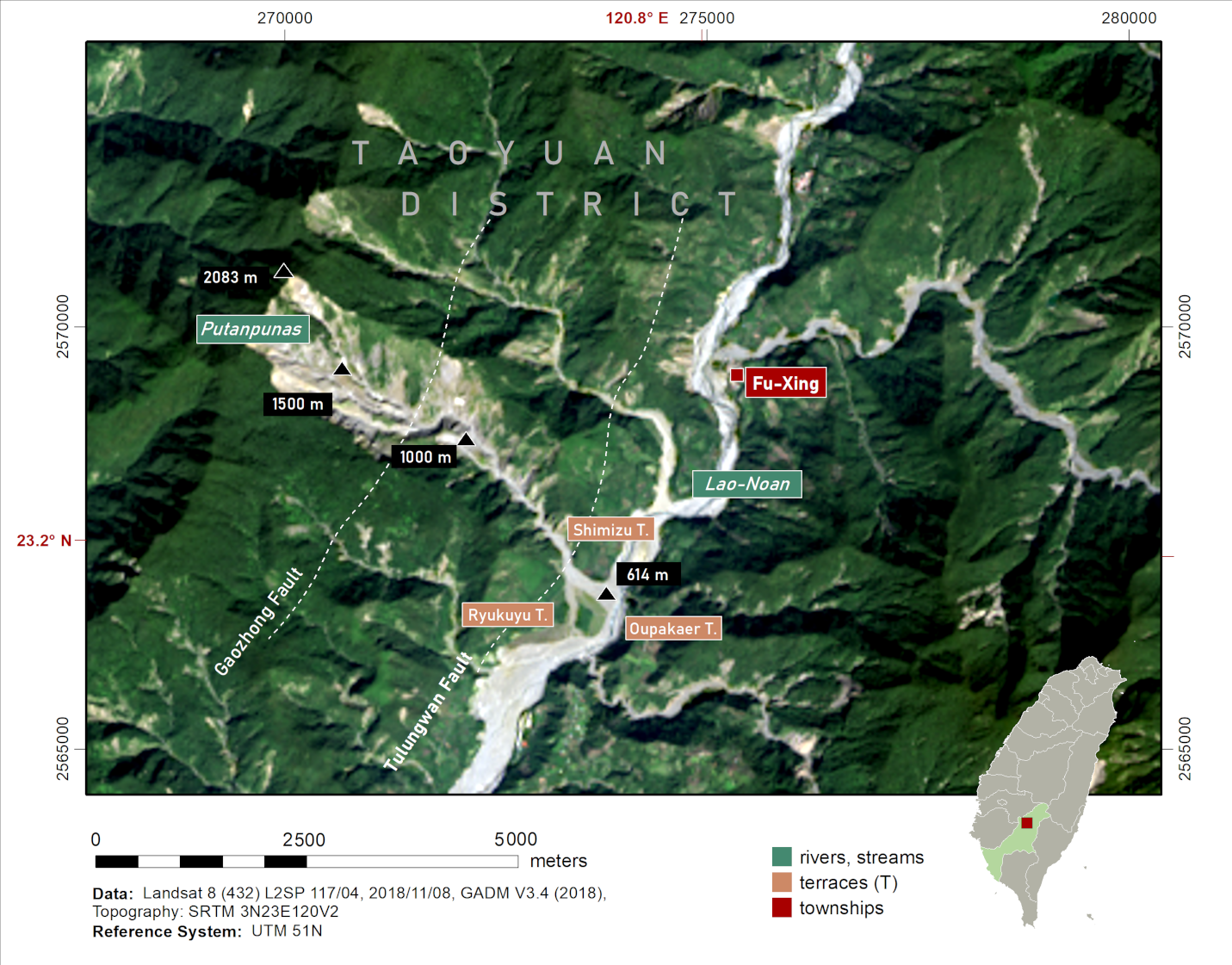
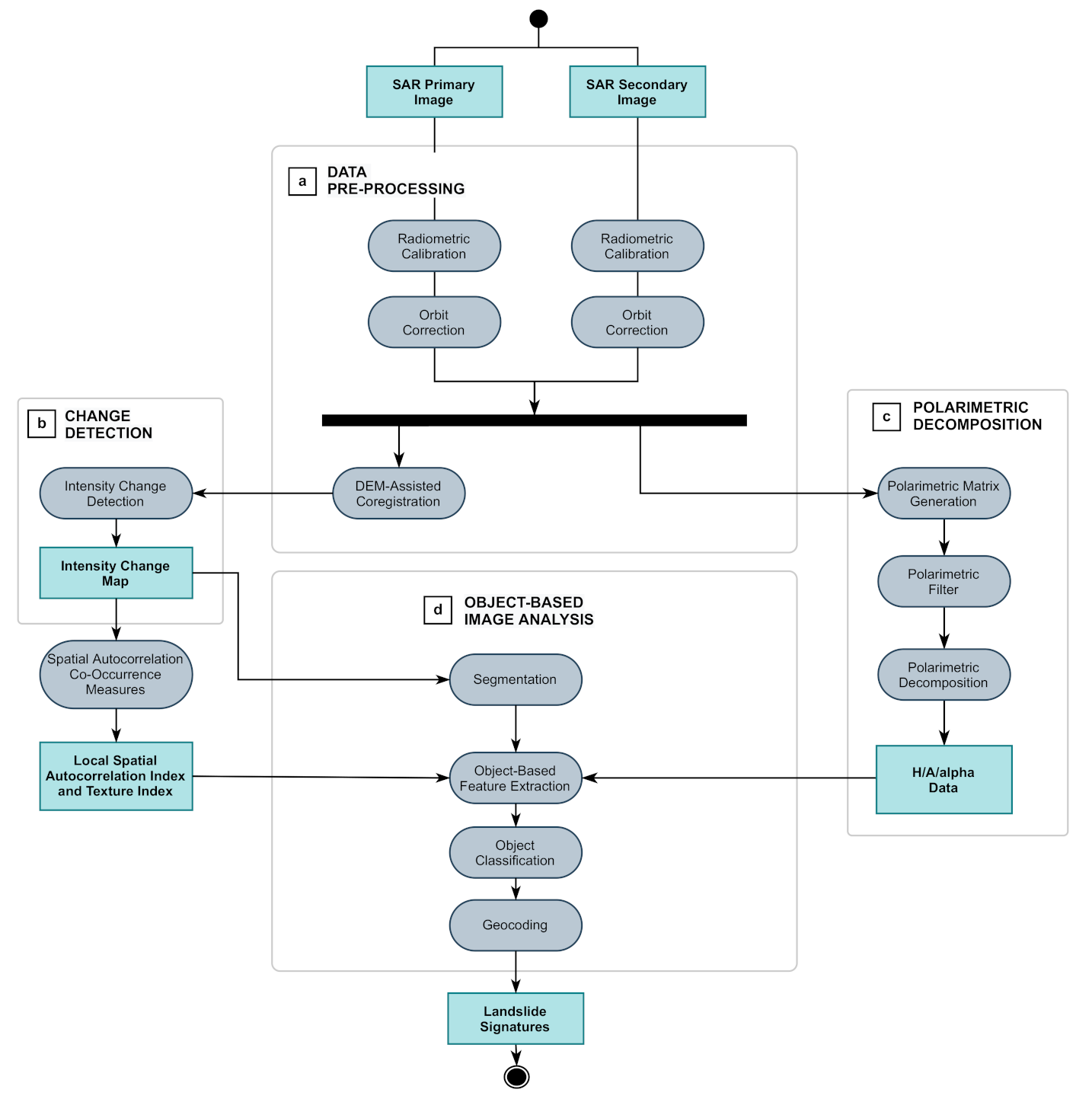

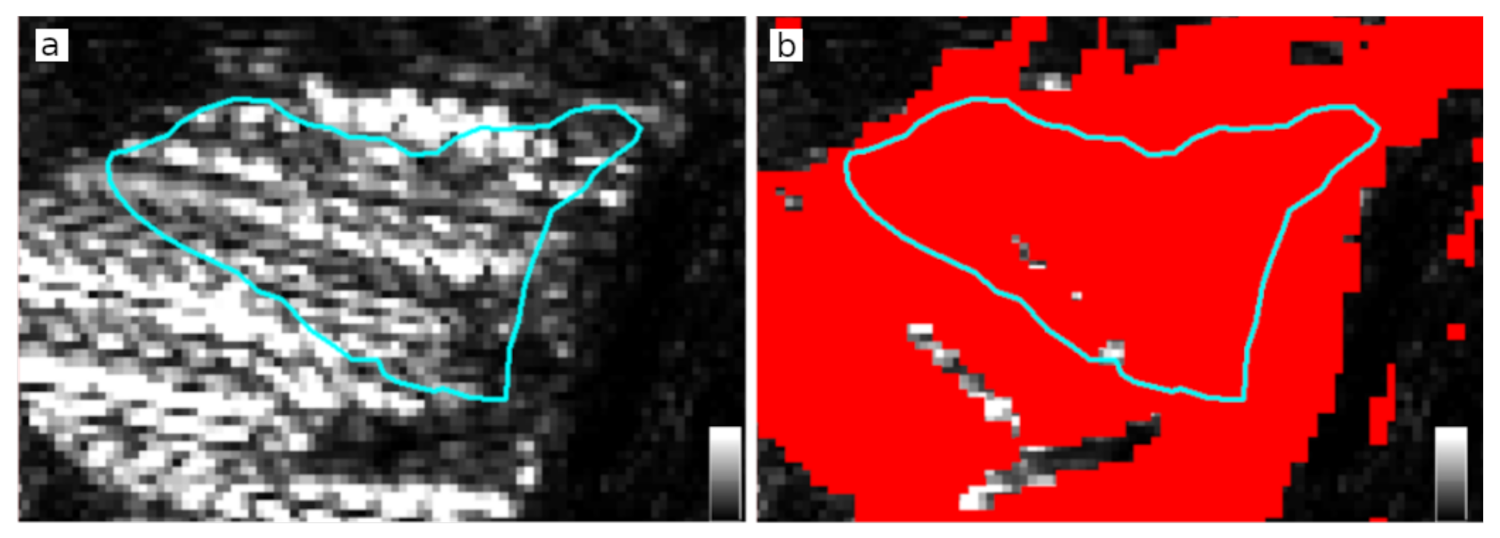
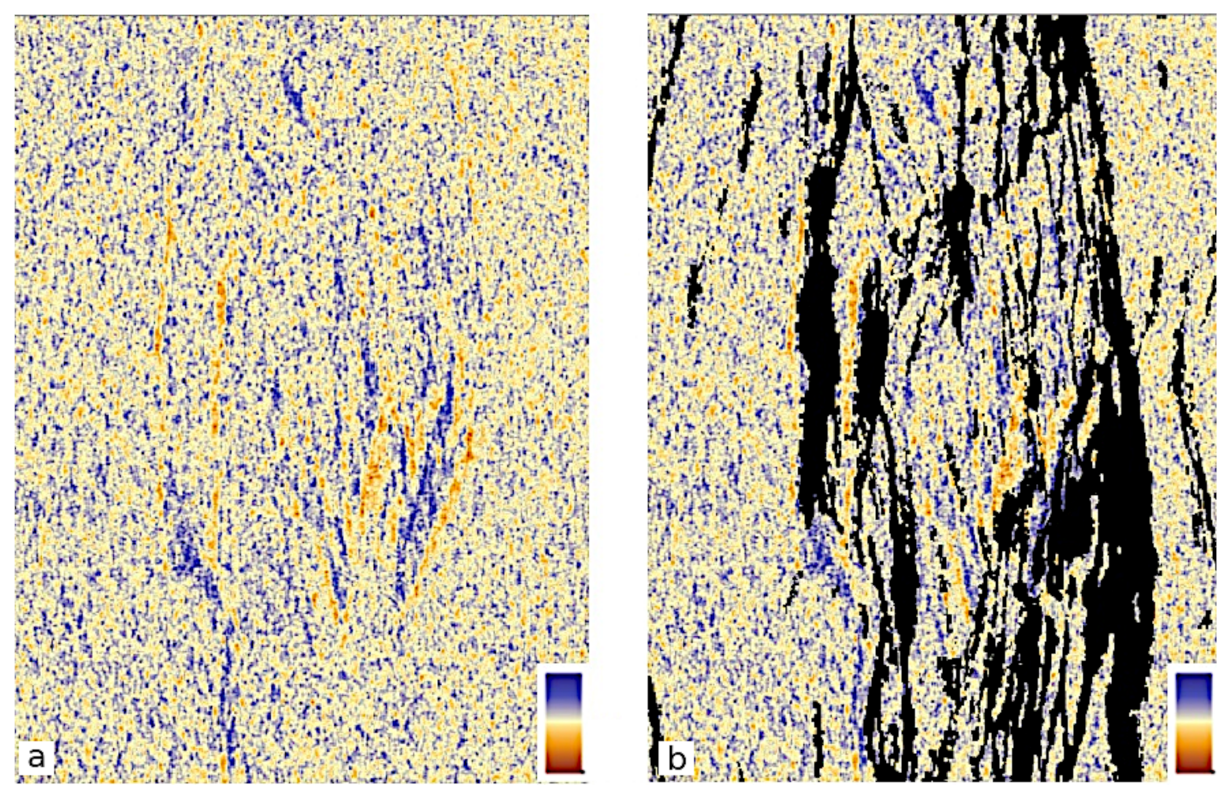

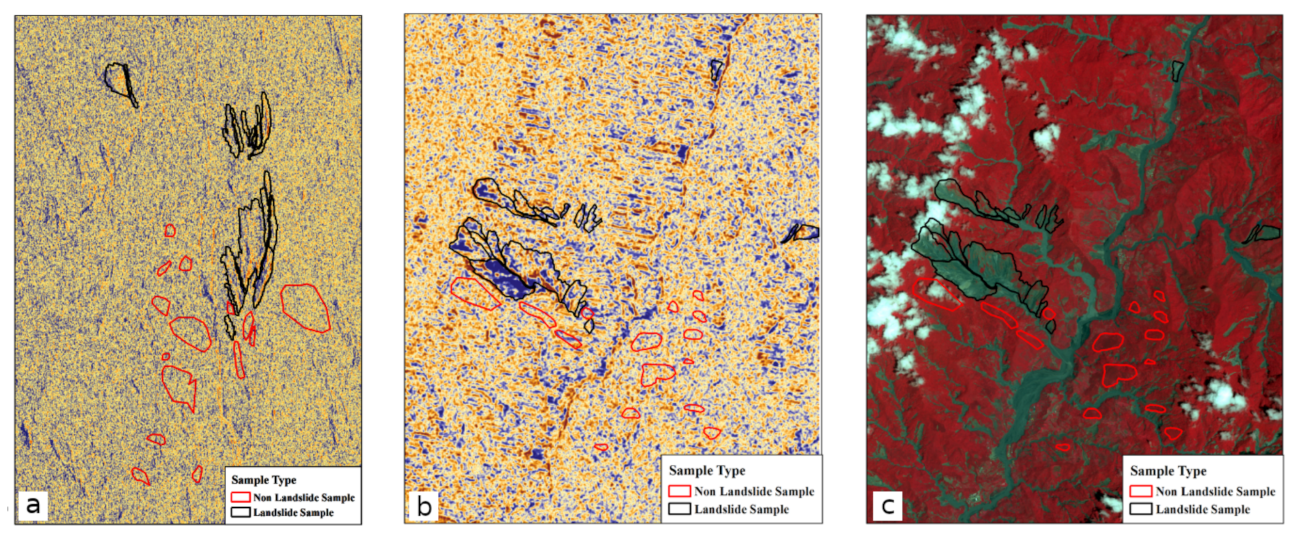
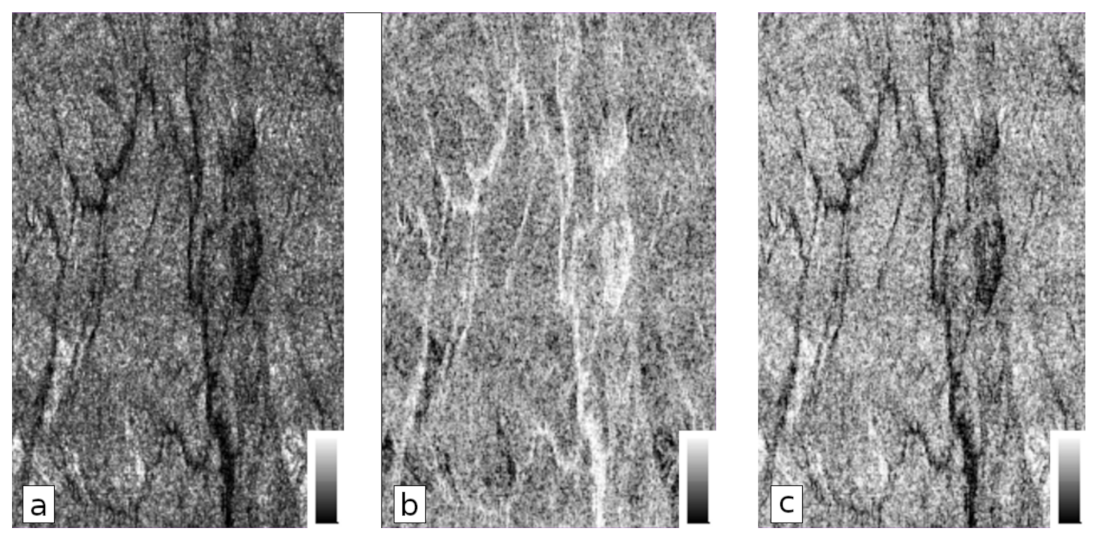

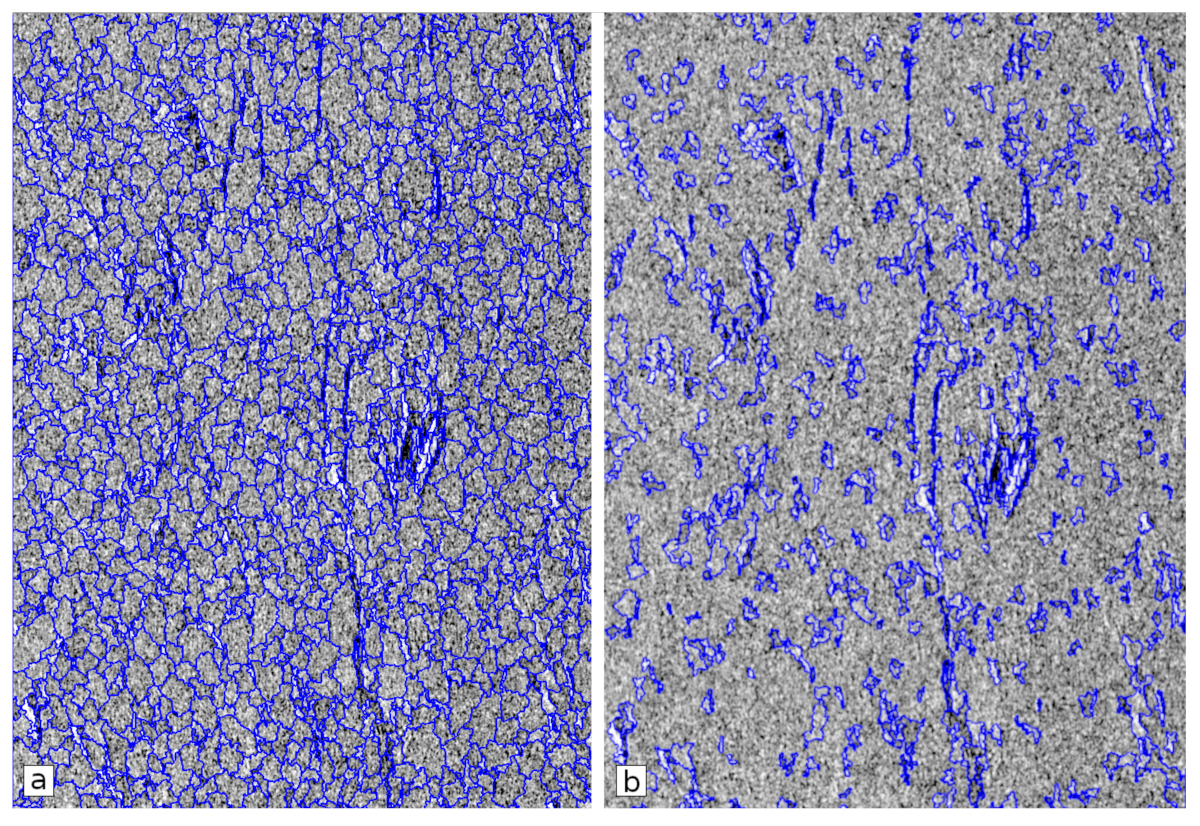


| Event and Date | SAR Data | Acquisition Date | Mode | Image Polarization | Resolution |
|---|---|---|---|---|---|
| Typhoon Morakot | ASAR | 2009/07/15 | Descending | VV, HH | 22 m |
| August 2009 | (AP mode) | 2009/08/19 | Descending | VV, VH |
| Areas with Landslides | Areas Devoid of Landslides | |
|---|---|---|
| Statistical Indices | ||
| Standard Deviation | 0.78–1.25 | 0.64–0.74 |
| Skewness | 0.56–1.54 | 1.57–1.86 |
| Polarimetric Decomposition | ||
| Entropy (P) | 0.52–0.71 | 0.74–0.84 |
| Anisotropy | 0.59–0.76 | 0.45–0.56 |
| Alpha | 12.76–20.98 | 22.23–28.04 |
| Spatial Autocorrelation | ||
| Getis-Ord Gi | 0.47–1.34 | 0.00–0.44 |
| Moran’s I | 0.77–2.39 | 0.49–0.71 |
| Geary’s C | 0.68–0.82 | 0.50–0.66 |
| Texture Indicators | ||
| Contrast | 55.56–113.44 | 37.56–52.69 |
| Dissimilarity | 5.81–8.51 | 4.81–5.77 |
| Homogeneity | 0.11–0.16 | 0.16–0.19 |
| Entropy (T) | 3.74–3.77 | 3.72–3.75 |
Publisher’s Note: MDPI stays neutral with regard to jurisdictional claims in published maps and institutional affiliations. |
© 2021 by the authors. Licensee MDPI, Basel, Switzerland. This article is an open access article distributed under the terms and conditions of the Creative Commons Attribution (CC BY) license (http://creativecommons.org/licenses/by/4.0/).
Share and Cite
Lin, S.-Y.; Lin, C.-W.; van Gasselt, S. Processing Framework for Landslide Detection Based on Synthetic Aperture Radar (SAR) Intensity-Image Analysis. Remote Sens. 2021, 13, 644. https://doi.org/10.3390/rs13040644
Lin S-Y, Lin C-W, van Gasselt S. Processing Framework for Landslide Detection Based on Synthetic Aperture Radar (SAR) Intensity-Image Analysis. Remote Sensing. 2021; 13(4):644. https://doi.org/10.3390/rs13040644
Chicago/Turabian StyleLin, Shih-Yuan, Cheng-Wei Lin, and Stephan van Gasselt. 2021. "Processing Framework for Landslide Detection Based on Synthetic Aperture Radar (SAR) Intensity-Image Analysis" Remote Sensing 13, no. 4: 644. https://doi.org/10.3390/rs13040644
APA StyleLin, S.-Y., Lin, C.-W., & van Gasselt, S. (2021). Processing Framework for Landslide Detection Based on Synthetic Aperture Radar (SAR) Intensity-Image Analysis. Remote Sensing, 13(4), 644. https://doi.org/10.3390/rs13040644






